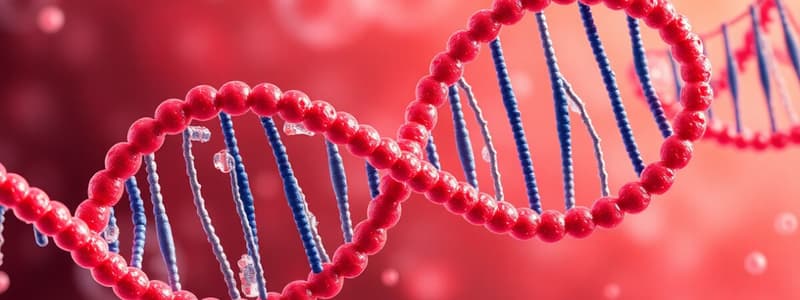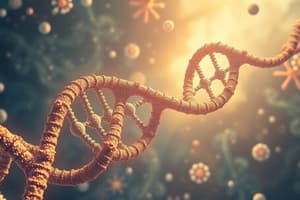Podcast
Questions and Answers
Which model of DNA replication is characterized by the parental molecule directing the synthesis of an entirely new double-stranded molecule?
Which model of DNA replication is characterized by the parental molecule directing the synthesis of an entirely new double-stranded molecule?
- Conservative (correct)
- Dispersive
- Semi Conservative
- Repetitive
During DNA replication in eukaryotes, how many replication bubbles are typically present?
During DNA replication in eukaryotes, how many replication bubbles are typically present?
- One
- Few dozen
- Thousands (correct)
- Multiple chains
What enzyme is responsible for unzipping the double helix structure of DNA during the replication process?
What enzyme is responsible for unzipping the double helix structure of DNA during the replication process?
- Topoisomerase
- Helicase (correct)
- DNA polymerase
- DNA ligase
In which phase of the cell cycle does DNA replication take place?
In which phase of the cell cycle does DNA replication take place?
What is created after one round of semi-conservative DNA replication?
What is created after one round of semi-conservative DNA replication?
Flashcards
DNA Replication
DNA Replication
The process by which DNA makes a copy of itself during cell division.
DNA Replication
DNA Replication
The process by which DNA makes a copy of itself during cell division.
Helicase
Helicase
Enzyme that breaks the hydrogen bonds between DNA bases, separating the double helix into two single strands.
Replication Fork
Replication Fork
Signup and view all the flashcards
Origin of Replication (ori)
Origin of Replication (ori)
Signup and view all the flashcards
Study Notes
DNA Replication
- DNA replication is the process where DNA makes a copy of itself during cell division.
- DNA must be copied before cell division to ensure both daughter cells receive identical DNA strands.
- DNA replication occurs during the S (synthesis) phase of interphase.
- DNA replication takes place in the S phase in eukaryotes.
- Site of DNA replication is the nucleus of eukaryotes.
Models of Replication
- There are three models of DNA replication: conservative, semi-conservative, and dispersive.
- Conservative: The parental molecule directs synthesis of an entirely new double-stranded molecule, and the original molecule remains intact after one round.
- Semi-conservative: The two parental strands separate, and each makes a copy of itself. After one round, the two daughter molecules each comprise one old and one new strand. This is the correct model.
- Dispersive: Material in the two parental strands is distributed randomly between two daughter molecules.
Semiconservative DNA Replication
- Daughter DNA is a double helix with one parent strand, and one new strand.
- One strand serves as a template for the synthesis of the new strand.
DNA Template
- Each strand of the parent DNA serves as a template for the new daughter strand.
- DNA replication produces two new complete double helices, each with one old and one new strand.
Replication Origin
- The site where replication begins is called ori.
- There is one oriC in E. coli, and thousands (oris) in humans.
- Strands are separated to allow replication machinery to contact DNA.
- Many A-T base pairs are present at replication origins.
- DNA strands run anti-parallel.
Replication Bubble in Prokaryotes & Eukaryotes
- Prokaryotes (bacteria) have a single replication bubble.
- Eukaryotic chromosomes have multiple replication bubbles.
- Replication initiates at a single site in prokaryotes, and at multiple sites in eukaryotes.
Steps of DNA Replication
- Unzipping: DNA helicase breaks the weak hydrogen bonds between bases, separating the two strands and creating a replication fork.
- The replication fork forms a Y-shape, and each strand acts as a template.
DNA Helicase
- DNA helicase unwinds the DNA double helix.
Single-Strand Binding Proteins (SSBs)
- SSBs attach and keep the two DNA strands separated and untwisted, helping to stabilize the single strands.
DNA Topoisomerase
- DNA topoisomerase relieves the stress on the DNA molecule caused by unwinding.
- There are two types of Topoisomerases:
- Type I: makes a transient single cut to allow strands to swivel, relieving twists.
- Type II (DNA gyrase): introduces double-stranded breaks allowing one strand to pass through another in order to remove knots and entanglements.
Quinolones and Fluoroquinolones
- The fluoroquinolones inhibit type 2 bacterial DNA topoisomerases (including DNA gyrase and topoisomerase IV).
- This binding blocks DNA synthesis and cell growth, having a lethal effect on the cell.
Replication Fork
- The replication fork moves bidirectionally.
Leading and Lagging Strands
- One strand is oriented in the 3' to 5' direction (towards the replication fork) - leading strand.
- The other strand is oriented in the 5' to 3' direction (away from the replication fork) - lagging strand.
- The two strands are replicated differently due to their different orientations.
DNA Polymerase
- In prokaryotes, there are three types of DNA polymerases (I, II, and III).
- An enzyme (Pol III) catalyzes the addition of nucleotides to the growing DNA chain.
- Nucleotide triphosphate enters as a substrate for DNA synthesis and the reaction releases pyrophosphate.
- DNA Replication proceeds 5' to 3'. (The newly synthesized strand always grows from 5' to 3', using the existing strand as its template).
DNA Polymerase Complex
- In E. coli, polymerase III (Pol III) functions at the replication fork, and catalyzes the highest rate of chain elongation, and is the most processive.
- DNA polymerase II (Pol II) is mainly involved in proofreading and repair.
- DNA polymerase I (Pol I) completes chain synthesis between Okazaki fragments on the lagging strand.
Differences between DNA Polymerases I, II and III
- A table comparing Polymerization Rate, Processivity, Proofreading, Primer Removal, Strand Synthesis, and DNA repair of DNA polymerases I, II and III.
Eukaryotic DNA Polymerase
- Eukaryotic cells have counterparts (similar versions) of each of the prokaryotic DNA polymerases, plus some additional ones.
- A comparison table is provided for the mammalian counterparts of the E. coli polymerases.
Primase
- Primase synthesizes a short RNA chain (primer).
- The primer is a short RNA/DNA hybrid necessary for initiating DNA synthesis, with RNA and DNA base-pairing rules (A-U and C-G).
- Later the primer RNA is removed and replaced with DNA to make a continuous DNA chain.
- In eukaryotes, primase is part of DNA polymerase Alpha.
Primers
- Simple addition of primer along the leading strand, but many primers are needed along the lagging strand.
- DNA polymerase needs a primer to begin building a new DNA strand. Multiple primers are needed on the lagging strand.
How is DNA Synthesized
- Along the leading strand, DNA polymerase reads 3' → 5' from the RNA primer, synthesis proceeds 5' → 3' with the new daughter strand. Nucleotides are added starting at 5' end and continue in the 3' direction.
- Along the lagging strand, synthesis proceeds in the opposite direction (5' → 3') for the template strand. Short Okazaki fragments are created and sealed by DNA ligase for continuous strand.
Okazaki Fragments
- The method of lagging strand synthesis produces Okazaki fragments.
- Exonuclease strips away the primers, and complementary nucleotides fill the gaps.
- DNA ligase seals up the sequence.
Components of the DNA Replication
- The components of DNA replication are illustrated in a diagram.
- The illustration shows components like the parental DNA helix, various enzymes involved, leading strand template, and other components.
Studying That Suits You
Use AI to generate personalized quizzes and flashcards to suit your learning preferences.




